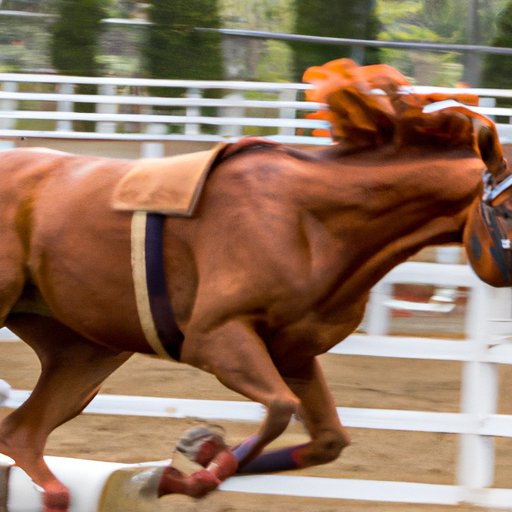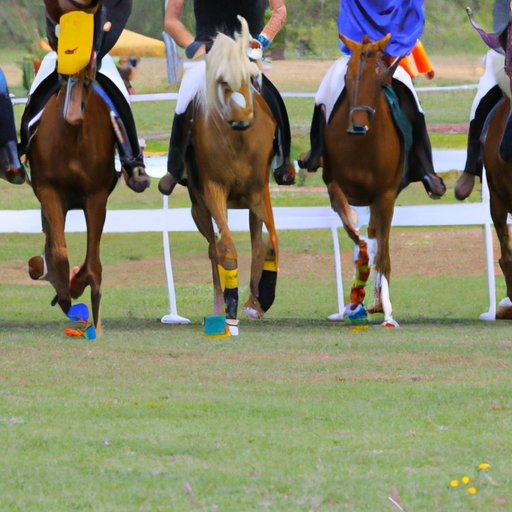Introduction
Horses have long been revered for their beauty, grace and speed. From the early days of chariot racing to modern day flat and steeplechase races, the horse has been an integral part of human history. But just how fast can a horse go? This article will explore the various factors that influence horse speed, from physiology and genetics to training and care.
The Anatomy of a Horse’s Speed: Exploring How Quickly Horses Can Move
The speed of a horse is determined by many factors, including its physiology, muscles, bones and joints, as well as the type of race it is running. To understand how quickly horses can move, let’s take a closer look at each of these elements.
Physiology of Horse Movement
The way a horse moves is largely determined by its physiology. The skeletal system of a horse consists of more than 200 bones, which are connected by ligaments, tendons and muscles. These bones, along with the muscles and joints, work together to allow the horse to move in a fluid, efficient manner. A horse’s muscles play a key role in its speed, as they provide the power and propulsion needed to move forward.
Muscles, Bones and Joints
The bones of a horse are strong and durable, allowing it to gallop and jump without fear of injury. The muscles of a horse are made up of two types: slow twitch and fast twitch. Slow twitch muscles are responsible for endurance and are used for long-distance races. Fast twitch muscles are used for short bursts of speed, such as sprinting or jumping. The joints of a horse also play a role in its speed; the hock joint, for example, provides powerful thrust when the horse takes off from a standing start.
Limitations of Horse Speed
While horses can reach impressive speeds, there are certain limitations to their speed. Weight is one of the most significant factors; the heavier the horse, the slower it will be. Age is another factor; young horses tend to be faster than older horses. Additionally, the terrain can affect a horse’s speed; soft, wet ground will slow a horse down, while dry, hard ground will allow it to move more quickly.
An Overview of the Different Types of Horse Racing and their Top Speeds
There are several different types of horse racing, each with its own unique rules and regulations. Let’s take a look at some of the most popular types of horse racing and their top speeds.
Thoroughbred Races
Thoroughbred racing is the most common type of horse racing. Thoroughbreds are bred specifically for racing and are usually capable of reaching speeds of up to 40 mph. However, the fastest recorded thoroughbred race was won by Secretariat in 1973, who reached a speed of 43 mph.
Harness Racing
Harness racing is another popular type of horse racing. In this type of race, the horse pulls a small cart called a sulky behind it. Harness racing horses can often reach speeds of up to 30 mph, though some have been known to reach speeds of up to 40 mph.
Rodeo Events
Rodeo events such as barrel racing and steer wrestling involve horses competing at high speeds. Barrel racing horses can reach speeds of up to 45 mph, while steer wrestling horses can reach speeds of up to 60 mph.
Endurance Racing
Endurance racing is a type of long-distance horse race. These races typically cover distances of up to 100 miles and horses must maintain a steady pace throughout the race. Endurance horses usually reach speeds of up to 15 mph, but can reach speeds of up to 25 mph on flat terrain.
Record-Breaking Races: Examining the Fastest Horses in History
Throughout history, there have been numerous record-breaking races. Some of the fastest horses in history include Secretariat, War Admiral and Man o’ War. Each of these horses set world records for their respective races, reaching speeds of up to 43 mph.
List of World Record Holders
- Secretariat (43 mph)
- War Admiral (41 mph)
- Man o’ War (40 mph)
Factors that Contribute to Record Setting Races
In order for a horse to set a world record, several factors must come into play. The horse must be healthy and fit, the rider must be skilled and experienced, and the track must be in perfect condition. Additionally, the weather must be favorable and the horse should have the right equipment, such as shoes and tack.
Training Tips for Owners to Maximize Their Horse’s Speed
Owners who want to maximize their horse’s speed should focus on nutrition, exercise and grooming. Here are some tips to help owners get the most out of their horse.
Diet and Nutrition
A horse’s diet should be tailored to its individual needs. High-quality hay and grain should be fed, supplemented with vitamins and minerals as needed. The horse should also have access to fresh water at all times.
Exercise and Conditioning
Regular exercise and conditioning are essential for a horse to stay fit and healthy. Owners should ensure that their horse gets enough rest between workouts, and should gradually increase the intensity of the workouts over time.
Grooming and Care
Proper grooming and care are important for a horse’s health and performance. Grooming not only keeps the horse looking its best, but it also helps to keep its coat and skin healthy. Additionally, owners should check the horse’s hooves regularly and provide regular veterinary care.
Physiological Breakdown: What Makes a Horse Run So Fast?
When a horse runs, its body goes through a series of physiological changes. Let’s take a look at what happens inside the horse’s body when it is running at its top speed.
Heart Rate
When a horse is running, its heart rate increases significantly. During a race, a horse’s heart rate can reach up to 200 beats per minute.
Respiration
When a horse is running, its respiration rate also increases. During a race, a horse’s respiration rate can reach up to 200 breaths per minute.
Metabolism
When a horse is running, its metabolism increases significantly. As the horse runs, its body burns more energy, which helps it to maintain its speed.

Exploring the Genetics Behind Horse Speed
Genetics play an important role in determining a horse’s speed. While some horses are naturally gifted runners, others may require more training and conditioning in order to reach their maximum speed potential.
Genetic Variations
Horses come in a variety of shapes and sizes, and their speed potential varies depending on their genetics. Some horses are naturally gifted runners, while others may need more training and conditioning to reach their full potential.
Breeding for Speed
In addition to genetics, breeders can also select for traits that can improve a horse’s speed. Breeding for speed involves selecting horses with the desired traits and then breeding them together to produce offspring with the desired characteristics.

Comparing Horse Speeds Across Breeds and Disciplines
Horse speeds vary across breeds and disciplines. Let’s take a look at some of the average speeds by breed and discipline.
Average Speeds by Breed
- Thoroughbreds: 35-45 mph
- Standardbreds: 25-35 mph
- Quarter Horses: 20-30 mph
- Arabians: 15-25 mph
Variance in Speeds Across Disciplines
- Sprint Races: 30-45 mph
- Middle Distance Races: 25-35 mph
- Long Distance Races: 15-25 mph
- Barrel Racing: 40-50 mph
- Steer Wrestling: 50-60 mph
Conclusion
Horses are amazing creatures capable of reaching incredible speeds. This article has explored the anatomy of horse movement, the different types of horse racing and their top speeds, record-breaking horses, training tips, and the physiological and genetic factors that influence speed. While horses can reach impressive speeds, it is important to remember that they have limitations, and owners should always take care to ensure that their horses are healthy, fit and properly cared for.
Summary of Findings
This article explored the various factors that influence horse speed, from physiology and genetics to training and care. We looked at the anatomy of horse movement, the different types of horse racing and their top speeds, record-breaking horses, training tips, and the physiological and genetic factors that influence speed. We also examined the average speeds of different breeds and discussed the variance in speeds across disciplines.
Final Thoughts
Horses are beautiful, graceful animals capable of reaching remarkable speeds. By understanding the factors that influence horse speed, owners can ensure that their horses are healthy, fit and properly cared for, and can help them reach their full potential.
(Note: Is this article not meeting your expectations? Do you have knowledge or insights to share? Unlock new opportunities and expand your reach by joining our authors team. Click Registration to join us and share your expertise with our readers.)
